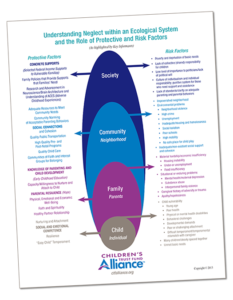Preventing Child Neglect
ON THIS PAGE: Research & Theory of Change | Training | Resources
Research and Theory of Change

Child neglect is the most prevalent form of child maltreatment, with serious and long-term consequences. It is also the least clearly defined, understood and publicly recognized. The Alliance, with funding from the Doris Duke Charitable Foundation, is conducting a targeted effort to raise the visibility of this issue and expand the national conversation about preventing neglect.
The work builds on the Alliance’s extensive work to promote the Protective Factors framework, key informant interviews, research findings reported in the literature and other strategies for identifying what works. The research has provided a solid foundation for tools, training and other diverse materials. These provide a background for the national conversation, and will allow you to take the conversation into your own neighborhoods and communities: Child Neglect Is Preventable!
Research
Child neglect is an act of omission and the most prevalent type of child maltreatment. The limited understanding of the complexities associated with its incidence, prevalence and devastating impacts are illusive in large part due to its “hidden” nature. Relationships between neglect and poverty, substance abuse, mental illness, interpersonal violence, and histories of trauma are not well understood. Thus, the base of evidence is limited and uneven.
The Key Informant Interview Protocol, a qualitative research method, is intended to generate and disseminate expert knowledge, develop a conceptual framework and support effective practice implementation.
In this research, from November 2012 through January 2013, 22 key informant (KI) interviews were conducted with individuals with varied expertise, experiences and perspectives about child neglect and its prevention. The overarching framework of the interview was anchored in the socio-ecological model and respondents were asked questions in which their responses addressed each level of this model – child, parents/family, neighborhood/community and society.
Discover what the research illuminates about:
- Protective and Risk Factors at each of the four levels of the Socio-Ecological Model
- What is working well at the family, community, system and policy levels to prevent neglect
- What efforts are needed to be made to make significant progress on preventing neglect
- Identification of the role and contributions to be made by the Alliance
- Identification of the roles and contributions to be made by the State Children’s Trust Funds
Documents
Theory of Change
The research gathered in the Key Informant Interviews allowed the Alliance to bring this information to the attention off its membership through both in-person and virtual convenings. These structured conversations engaged Children’s Trust and Prevention Fund staff from across the country in order to develop a Theory of Change. The Theory of Change identifies a set of assumptions and actions that we all can take with children, families, communities and society in order to prevent child neglect.
Training
The Alliance is committed to raising the visibility for the prevention of child neglect and expanding the national conversation about the fact that child neglect is preventable. Here you will find tools to share results of the research and stimulating training sequences that will initiate these conversations in your communities. As always, you will hear and see parents discuss the issue of preventing child neglect and what we all can do.
Let’s Talk About… Preventing Child Neglect
Training Sequences
The four training sequences are designed to be used serially, with each segment building on the content of the previous segment. The content is intended to raise public awareness about child neglect, protective factors that help shield children and families, and manageable steps that each of us can take to help reduce the likelihood of child neglect.
How to Use the Training Sequences
The concept is simple. Begin by using the video segments or the Prezi presentations as springboards for a discussion and meaningful conversation. The supporting materials will help you use the materials in diverse settings.
Supporting Materials
Each of the four training sequences includes:
- A dynamic video or Prezi presentation that explores the topic and incorporates parent voices
- A robust discussion toolkit that provides:
- Learning objectives
- Guidance for working through the training sequence individually or in a small, medium or large group settings
- A reflection journal with questions to consider
- A coloring sheet to engage learners, reinforce key messages and serve as a colorful reminder once the training sequence has been completed
- Links to additional resources
Resources
The Prezi files below contain separate files for Mac and PC users. Mac users, open the .zip file labeled ‘Mac’ and the subsequent folder contains the Portable Prezi file that will open in a standalone window. PC users open the .exe file marked ‘Windows’.
- Explore the Basics (#1)
- Fact or Fiction (#2)
- Everyone’s Responsibility (#3)
- What We All Can Do (#4)
Resources
Tools Developed From the Research
The Alliance is committed to implementing and promoting innovative practices that are research-based and evidence driven. The Key Informant Interviews and related research are the basis for a series of tools that can be effective in helping to transform the results of the research into best practices for children and families.
The Research
Fact Sheets
Presentation Materials
 Infographics
Infographics
RESOURCE SHEET
Share this one-page handout of the Alliance’s resources to support the prevention of child neglect.
Sharing the Journey: Parent Stories on Preventing Child Neglect
These video stories were created by the Children’s Trust Fund Alliance in collaboration with FRIENDS National Center to gather parents’ perspectives and expertise from across the country on child neglect and the impact preventing it can have on families and communities. The videos discuss topics such as the protective factors, fatherhood and parenting.
